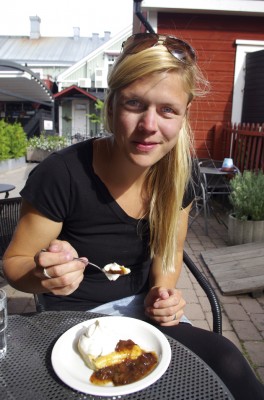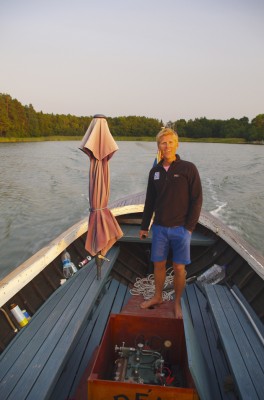Sauna on the waterfront
Just up from the waterfront was their sauna, which had an attached shower and a set of bunk beds for guests, where Mia and I slept to get off the boat. Behind the cottage was another tiny little hut which housed the washing machine (no dryer), larger refrigerator and the oven.
The main cottage was small, with room only for a dining table for two, a sitting room with a couple of bookshelves and a woodstove as the centrepiece. A tiny fridge and simple two-burner stove next to the single sink made up the kitchen. An outhouse was outside.
All the buildings on this little piece of land were painted dark green, blending right into the surrounding forest. The deck at the front probably had a larger footprint than the cottage itself, with a big dining table for six or eight and a handful of chairs and coffee tables. It overlooked the dock just down the sloping front yard, which was mostly grass intersected by a few large natural granite slabs.
Arcturus was anchored just off the dock. It felt as though we were inland. The water was only 5ft deep here and small fishing boats passed us as we made our way in to anchor. The reedy, forested shorelines were a decided change from the barren outcrops of the archipelago.
The boat drew attention from the neighbours and it was quickly apparent that a large sailboat – particularly one flying an American flag – was a rare sight. After Mia and I took our daily naked swim in the cove and had a sauna, we sat down for dinner on the deck. Shortly afterwards two of the neighbours wandered down to inquire about the yacht in the cove. As a proper host, Tryggve offered them cold beers and they sat down for a chat.
We learned that one of them had been a seaman on a ship in Gustav Erikson’s fleet back in the twilight days of merchant sailing ships, and had been across the Atlantic himself several times. Gustav Erikson is a household name around Åland, for he owned 17 of the last square-riggers to sail the grain route from Australia to England. Many Ålanders were captains and crew in Erikson’s fleet, a notable percentage of the 28,000-person population, in fact.
Later that evening another neighbour turned up, this time in an old wooden motor launch. We watched him approach the dock from the deck, Tryggve making sure I noted how smoothly the boat parted the water, ‘like a swan,’ he said.
Claes, at the helm, shouted for Tryggve to come down to the dock. He grabbed a cold beer first, and I followed him down. As they chatted, I asked if I could climb aboard.
“Absolutely!’ Claes replied.
“Start her up!’ he said in Swedish. No, no, I can’t do that, I said. The engine was ancient, a small green two-cylinder gasoline motor built in the 1940s. The boat itself was older, built of fir on the neighbouring island of Föglö in 1938, with tarred frames inside and a varnished hull outside.
Claes convinced me to turn the key and bring the thing to life, which I did with delight. By now Mia had come down to see what all the commotion was and the two of us took the little Adele out for a ride in the bay.
Adele was an open launch, about 25ft, with a beautiful canoe stern and graceful sheer. The controls were on the engine itself, a lever – cleverly made by Claes from an old piston – attached to the gearbox for forward and reverse, the throttle adjacent. You had to keep the cover off the engine box to drive the thing and you steered with a tiller. She was a real boat, and Claes was proud to have shared her with us.







